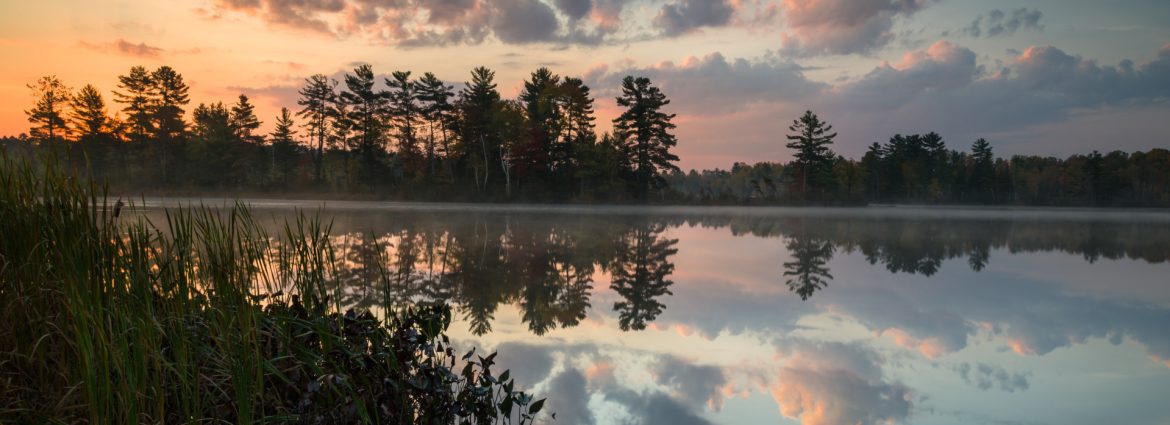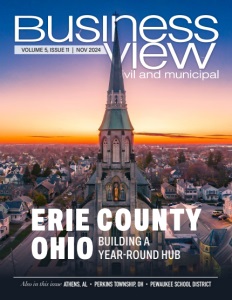Oneida County, Wisconsin
A Destination for All Seasons
Meshing economic development with environmental stewardship to provide a second-to-none lifestyle
In northern Wisconsin, Oneida County showcases a successful integration of economic development and environmental stewardship. Home to more than 38,000 residents, the county benefits from a varied economy that includes key industries, a thriving tourism sector, and a strong sense of community. Local leaders are focused on advancing growth while preserving the natural landscapes and high quality of life that is part of the area’s identity.
Land of dualities
Tony Pharo, Executive Director of Oneida County Economic Development Corporation (OCEDC), highlights the unique composition of the county’s economy, which is supported by manufacturing and tourism. “Rhinelander, our county seat and largest city, is a hub for manufacturing, while Minocqua and Three Lakes are focused heavily on tourism. We have this dual economy—manufacturing in one area and tourism in another.”
The division is evident in the county’s workforce. Rhinelander is home to several manufacturers, providing stable employment for residents in the area. At the same time, Minocqua and Three Lakes see a seasonal influx of visitors, transforming from small communities into bustling tourist destinations during the summer and winter months. “Minocqua’s population grows from around 5,000 people to 20,000 to 25,000 in the summer,” Pharo says.
Pete Otis, Secretary of Oneida County Economic Development Corporation (OCEDC) and long-time resident of Oneida County, adds another layer of understanding. “I live on a 500-acre lake, and about 90% of the homes around the lake are vacation homes. It’s quiet in the winter but a different story when summer hits.” Pharo mentioned, “I’ve seen a report recently that 52% of the homes in Oneida County are second homes.”
The power of tourism
Tourism is undoubtedly one of Oneida County’s strongest economic drivers. Visitors from nearby cities in Wisconsin, Illinois, and Minnesota flock to the county to enjoy its lakes, forests, and outdoor recreational opportunities. Whether it’s fishing and boating in the summer or snowmobiling and ice fishing in the winter, tourists are eager to experience the natural beauty of northern Wisconsin.
“Our county saw a 4.8% increase in tourism from 2022 to 2023,” Pharo shares. “That increase brought in $1.6 million in revenue, benefiting our businesses and local economy.” The tourism growth is significant, especially as the county recovers from the COVID-19 pandemic. However, as Pharo notes, maintaining sustainable tourism is a key focus for the OCEDC and local chambers of commerce.
“One of our priorities is to protect the natural resources that draw people here,” Pharo explains. “Our lakes and forests are a big part of what makes Oneida County special, and we’re committed to ensuring that tourism doesn’t negatively impact the environment.”
The county’s careful stewardship of its natural resources is reflected in its efforts to maintain clean water, preserve forested areas, and invest in parks. The OCEDC works closely with local chambers of commerce and tourism committees to ensure that tourism growth is balanced with environmental sustainability.

Overcoming the broadband challenge
While tourism plays a critical role in Oneida County’s economy, it’s not without its challenges. One of the country’s most significant obstacles in recent years was the lack of reliable broadband internet. This issue became particularly pressing during the COVID-19 pandemic when many second-home owners transitioned to working remotely.
“During COVID, we realized just how much of a broadband desert parts of the county were,” Otis says. “People who moved to their second homes found it difficult to work remotely because the internet speeds just weren’t fast enough.”
Otis, who has been involved in broadband development for over a decade, explains that efforts to expand broadband in Oneida County have been ongoing since 2013. The county’s broadband committee has made significant strides, secured grants, and worked with service providers to bring high-speed internet to more residents. About 58% of Oneida County currently has adequate broadband, and another 23% is connected through grants. “We’re working on a $28 million project to ensure that 82% of the county has access to broadband by 2028 and are working on getting new BEAD (Broadband Equity, Access, and Deployment) funding for another several million to hookup around 99% of our residents and businesses with the project set to be completed in late 2029 or 2030,” Pharo says.
The project, which involves laying fiber-optic cables throughout the county, will be transformative for residents and businesses. “Broadband isn’t just about convenience anymore,” Pharo explains. “It’s essential for our businesses, education, healthcare—it touches every part of life.”
Housing: The next frontier
While the broadband initiative is well underway, Oneida County faces another pressing challenge: housing. As the county’s manufacturing sector grows, finding affordable housing for new workers has become increasingly difficult.
“One of the biggest obstacles to growth is the lack of housing,” Leah VanZile, President of Oneida County Economic Development Corporation (OCEDC) Board of Directors explains. “Our manufacturers are expanding, but they’re struggling to find workers because there simply aren’t enough affordable homes available for employees.”
The housing shortage is felt throughout the county, particularly in Rhinelander, where many of the county’s largest employers are located. The OCEDC is actively working on solutions to this issue, including partnerships with local developers and exploring creative solutions such as converting motels into temporary housing for workers.
“We’re seeing businesses take matters into their own hands,” Otis shares. “One company bought a motel and converted it into housing for employees. It’s an innovative approach to dealing with the shortage, but it’s clear that we need more permanent solutions.”
The OCEDC is also working with local governments to explore zoning changes and tax incentives that could make it easier for developers to build new housing. “Housing is going to be one of our biggest focuses in the coming years,” Pharo says. “It’s directly tied to our ability to attract and retain workers, and it’s essential for our long-term growth.”
Supporting small businesses and entrepreneurs
While Oneida County’s manufacturing and tourism sectors are critical economic drivers, small businesses also play a vital role in the community. The county is home to numerous “mom and pop” shops, many of which have flourished thanks to support from the OCEDC.
During the COVID-19 pandemic, the OCEDC helped 37 small startups secure bounce-back grants, providing them with $10,000 each to cover rent or operating costs. “We’ve seen an incredible entrepreneurial spirit emerge after COVID,” Pharo says. “People are more willing than ever to take the leap and start their businesses.”
OCEDC’s sister corporation Northeast Wisconsin Economic Development Corporation (NEWEDC) has a revolving loan fund that helps support small businesses beyond grants. The organization offers a micro revolving loan fund, providing businesses with loans ranging from $5,000 to $35,000 to cover operating costs or help them secure bank financing. “We’re filling a critical gap for small businesses,” Pharo explains. “These loans help businesses get off the ground and grow until they qualify for conventional bank loans.”
One success story that stands out to Pharo and VanZile is that of two brothers who started a broadband company with the OCEDC’s help. “We helped them write their business plan and secure grants to build broadband towers,” Otis says. “They eventually sold the company to a larger provider, laying fiber throughout the county.”

Vision for growth and community
Looking ahead, Oneida County is ready for continued growth and development. With broadband expansion nearing completion in 2029, the county will be better equipped to attract new businesses, residents, and visitors. “Broadband is going to be a game-changer for us,” VanZile says. “It’s going to open up new opportunities for businesses and remote workers who want to move here and enjoy the quality of life we have in the Northwoods.”
However, broadband is just one piece of the puzzle. Housing remains a top priority, and the OCEDC is committed to finding solutions to make it easier for people to live and work in the county. “We need to make sure that we have enough affordable housing options for our workers,” Pharo says. “It’s critical for our economic future.”
“We’re seeing more people move to their second homes permanently,” Pharo says. “The quality of life draws them here—our parks, our lakes, our schools. It’s a great place to raise a family and build a life.”
Otis, who has lived in Oneida County since the 1970s, reflects on the community’s resilience and adaptability. “When I first moved here, it was a Paper Mill and Twist Drill Manufacturing town,” he says. “Now, we’ve got a thriving plastics industry, a growing tourism sector, and an entrepreneurial spirit that’s taken off. We’ve come a long way, and I’m excited to see where we’re headed.”
Quality of life in the Northwoods
“We want people to come here, raise their families, and contribute to our community,” Pharo says. “That’s what it’s all about creating a vibrant, sustainable community that people are proud to call home.”
Ultimately, Oneida County’s success comes down to its people—the residents, business owners, and local leaders committed to making their community a better place. “We take care of each other in the Northwoods,” Otis says. “That’s what makes this place so special. We’re all in it together and working toward the same goal—making Oneida County the best it can be.”
AT A GLANCE
Oneida County
What: A region known for manufacturing and its scenic beauty, featuring abundant forests and lakes that attract outdoor enthusiasts year-round.
Where: Northern Wisconsin
Website: https://www.oneidacountywi.gov/
PREFERRED VENDORS
AirPro – https://www.airprofan.com/
The team of innovators at AirPro brings together the best talent in engineering to design and develop industrial air products with the highest levels of integrity. While everything we manufacture is proudly made in the USA, customers around the world rely on our decades of combined expertise, ISO 9001:2015 certification, high-quality construction, on-time deliveries, emergent intervention, fast turnarounds, and our best-in-industry product guarantees.




